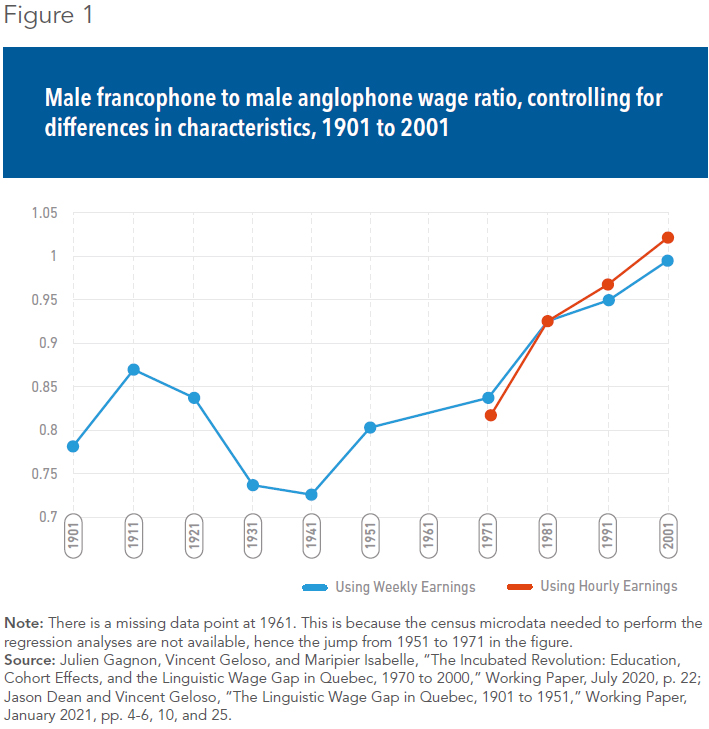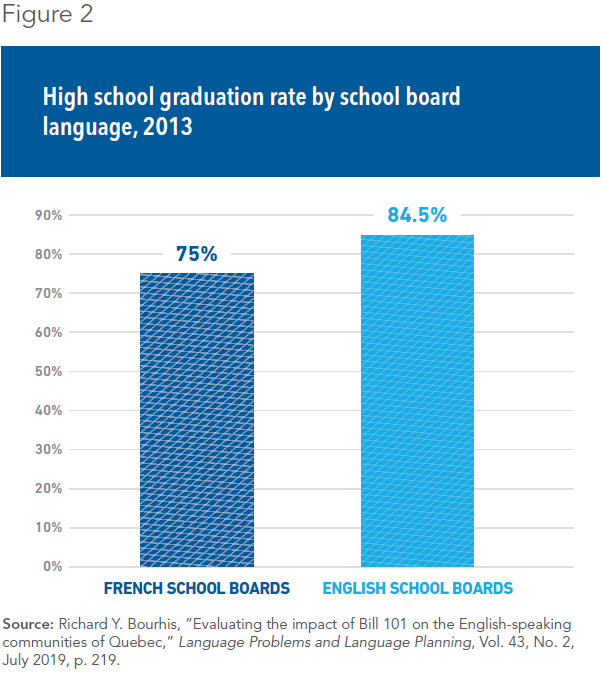Linguistic Vitality by Other Means

Economic Note showing that the key to the demographic vitality of the French language is its economic vitality
With the different levels of government intensifying their efforts to promote the use of the French language, an analysis of the economic history of Quebec identifies the real winning conditions for favouring the vitality of French. This publication shows the strong connection between the prosperity of francophones and the attractiveness of French in the province.
 Related Content
Related Content
 |
 |
 |
| Assurer la vitalité du français au Québec (Le Journal de Montréal, May 13, 2021)
Safeguard French by making Quebec richer (Financial Post, May 18, 2021) Favour prosperity of francophones over coercive language measures: MEI (The Suburban, May 19, 2021) |
Interview (in French) with Vincent Geloso (Midi Plus, 106,9 FM, May 14, 2021) | Interview with Vincent Geloso (CTV News Montreal at Noon, CFCF-TV, May 26, 2021) |
This Economic Note was prepared by Vincent Geloso, Associate Researcher at the MEI and Assistant Professor of Economics at George Mason University. The MEI’s Regulation Series aims to examine the often unintended consequences for individuals and businesses of various laws and rules, in contrast with their stated goals.
In the past decade, there has been a resurgence of debate regarding the vitality of the French language in Quebec.(1) Stemming from this, numerous proposals have been put forward to protect the French language and encourage its use.(2) Most of these are for direct policy measures to require the use of French at the expense of English, and so tend to privilege the stick over the carrot.
Yet the economic history of Quebec suggests that indirect measures that increase the economic returns of speaking French are more likely to ensure the vitality and use of the French language. In other words, the key to the demographic vitality of the French language is its economic vitality.
Language as Human Capital
The ability to speak a language is a form of human capital which, just like formal education, increases a person’s potential earnings.(3) Studies looking at immigrants to Canada show that the size of these returns is significant. All else being equal, immigrants who cannot conduct a conversation in either official language have earnings 10% to 12% lower than immigrants who can. The effect is larger (12% to 14%) for those who completed their schooling before immigrating.(4) Moreover, there is a rich body of evidence suggesting that people are sensitive to the returns from speaking a language in ways that explain rates of multilingualism.(5)
The two main economic determinants of the returns to learning a given language are i) the size of the group speaking the language and ii) the attributes of the members of that group. Simply put, if the members of a large linguistic group are all highly educated, the economic returns to the human capital embodied in the mastery of that group’s language are greater than if the group is smaller and its members less educated.
If the goal is to see rising rates of French usage in Quebec, one should find ways to increase the returns of speaking French relative to other languages. The size of the francophone community is difficult to affect directly through policy. However, the attributes of the members of the francophone community can be affected by public policy (in ways that can then later augment the size of the community, which would in turn further increase the attractiveness of the language). The economic history of Quebec illustrates the power of such policies.
The History of Language and Wages in Quebec
Until the 1940s, francophones in Quebec had distinctly lower levels of human capital than anglophones in the province.(6) This had three consequences. First, one must understand that there is a complementary relationship between human capital and other forms of capital: A piece of equipment is more productive in the hands of a skilled worker.(7) The high level of human capital embodied in anglophone workers attracted other forms of capital to be matched with them. This complementary relationship meant that anglophones had greater returns from education (in the form of higher earnings) than francophones.
The second consequence was that when immigrants arrived in Quebec, English was the more attractive language to learn. As a result, while roughly a third of immigrants spoke both French and English, the vast majority adopted English first and used it more extensively.(8)
The third consequence was that francophones were much more interested in mastering English than anglophones were in mastering French. As such, we observe high rates (oscillating around 35%) of bilingualism among francophones until the 1940s, while rates of bilingualism among anglophones were lower (and had fallen in the 1931 census compared with the 1901 census).(9)
However, in the 1940s, there was an important reversal following a series of educational reforms that compelled staying in school longer. This caused a rapid increase in educational achievement in the province. Whereas Quebec had been losing ground relative to the rest of Canada from 1911 to 1941, it subsequently started bouncing back and had closed a substantial portion of the gap by 1961.(10) Importantly, most of the post-1941 educational convergence was driven by rising levels of educational achievement among Quebec francophones.
The rise of a more educated and highly skilled francophone workforce made it more attractive to match them with complementary forms of physical capital. As this happened, the rate of return on human capital for francophones gradually converged with the rate of return for anglophones. This is best observed by considering birth cohorts to capture the effect of the educational reforms of the 1940s. For those born just before the reforms, the francophone cohort had a rate of return on education of 11.9%, as opposed to 19.3% for anglophones. The francophone cohorts most affected by the reforms saw their rates of return increase to 18.5%, compared to 18.7% for their anglophone peers.(11)
There are other signs of greater matching of physical capital with francophones. Consider, for example, the case of business ownership. During the first half of the 20th century, rates of francophone ownership of firms declined gradually, and they stood at 47% by 1961.(12) However, this trend was reversed during the 1950s or 1960s(13) as those rates surged upward, reaching 67% by 2003.(14) This greater level of ownership of firms by francophones was particularly pronounced in the financial sector, where francophone ownership grew from 26% in 1961 to 60% by 2003.(15)
The development of francophone human capital, and the complementary relationship between this and other forms of capital, meant that the wage gap between anglophones and francophones was gradually closed. Figure 1 depicts the wage gap between male unilingual francophones and male unilingual anglophones controlling for other confounding factors such as age, experience, marital status, and sector of work.(16) As it shows, there was divergence between francophones and anglophones in the three decades prior to 1941. However, after 1941, francophones steadily caught up with anglophones so that the wage gap had essentially disappeared by 2001.

Moreover, it is worth pointing out that Figure 1 understates the pace of convergence experienced after the 1940s. The first cohort of francophones affected by the reforms of the 1940s actually showed no significant wage penalty relative to anglophones.(17) However, these more educated cohorts only gradually entered the workforce, so that there appears to be a delay in reaching parity. In truth, by 1978, there were no longer any significant differences between young francophones and young anglophones.(18) Moreover, studies that extend the comparison past 2001 show that unilingual anglophones today actually earn less than unilingual francophones, all else being equal.(19)
The collapse of the wage gap speaks directly to the issue of the economic vitality of the French language. As expected, the economic vibrancy of the francophone community that emerged as a result of more educated workers and more capital being matched with these workers made French a much more attractive language to master. Three facts support this connection, and all of these facts involve changes in the decades prior to the adoption of Bill 101, which means that language laws play no role in explaining these trends. First, rates of bilingualism among anglophones began to increase steadily.(20) Second, the share of allophones who could speak both official languages, as opposed to only English, began to increase.(21) Both non-francophone groups exhibited rates of French knowledge equal to 28% for women and 36% for men in 1951. By 1971, these proportions had jumped to 37% and 43%, respectively,(22) and continued to increase thereafter.(23) Third, there were signs of a rising propensity for immigrants to send their children to French schools (although the rate was admittedly well below what has been observed since Bill 101).(24)
Policy Lessons: The Carrot vs. the Stick
These facts point to a strong connection between the economic attractiveness of the French language and its long-run demographic vitality. Such a connection provides us with an important policy lesson: The road to French demographic vitality can be a roundabout one. The educational reforms of the 1940s were not meant to directly deal with the attractiveness of the French language among anglophones and immigrants. However, they did end up increasing its attractiveness. As such, policies that focus on improving the prosperity of the francophone community may yield larger and more impressive long-run returns.
Such policies should try to replicate the effects of the educational reforms of the 1940s. Today, francophones in Quebec still exhibit lower levels of educational outcomes than anglophones. A study by the Institut National de la Santé Publique du Québec showed that in 2006, 23% of Quebec’s anglophone population over the age of fifteen had at least a college degree, compared to 15% for francophones. The study also found that high school non-completion for this age group was 25% for francophones versus 20% for anglophones.(25) Quebec Education Department data, for its part, showed that in 2013, high school graduation rates for that year were almost ten percentage points higher in the province’s English school boards than in its French school boards(26) (see Figure 2).

Policies aimed at increasing the returns to education, reducing high school dropout rates, and increasing technical college and university completion rates should thus be considered as viable ways of securing the status of the French language in Quebec.(27) That is to say, higher levels of human capital among francophones would increase the productivity of that group in ways that make it more attractive for anglophones and allophones to learn French in order to interact with that higher-productivity group.
There are, of course, other policy avenues available to governments that would more directly attempt to secure the position of the French language. But in light of Quebec’s economic history, these seem to offer little promise of yielding sizable effects. None of the policy proposals currently being discussed (extending Bill 101 to CEGEPs for instance) seem to offer anything approaching the effects of mandatory elementary and secondary schooling in French that resulted from Bill 101. This is because we have likely taken the stick approach as far as it can go. At this point, only carrots are likely to lead to a wider use of French in Quebec.
References
- Alex Arsenault Morin and Vincent Geloso, “Multilingualism and the decline of French in Quebec,” Journal of Multilingual and Multicultural Development, Vol. 41, No. 5, October 2019, pp. 420-431; Jean Ferretti, “Le Québec rate sa cible: les efforts du Québec en matière de francisation et d’intégration des immigrants: un portrait,” Institut de recherche en économie contemporaine, January 2016, pp. 8-9; Victor Piché, “The politics of numbers: Quebec’s historical struggle with ethnic and linguistic categories,” Ethnic and Racial Studies, Vol. 40, No. 13, July 2017, pp. 2318-2325; Alain Bélanger and Patrick Sabourin, “De l’interprétation des indicateurs linguistiques du recensement canadien,” Cahiers québécois de démographie, Vol. 42, No. 1, 2013, pp. 167-177.
- Marco Blair-Cirino, “La survie du français passe par l’État québécois, soutient Simon Jolin-Barrette,” Le Devoir, September 14, 2020.
- Hoyt Bleakley and Aimee Chin, “Language skills and earnings: Evidence from childhood immigrants,” Review of Economics and Statistics, Vol. 86, No. 2, May 2004, p. 490; Edward P. Lazear, “Culture and language,” Journal of Political Economy, Vol. 107, No. S6, December 1999, p. S124; Krishna Pendakur and Ravi Pendakur, “Language as both human capital and ethnicity,” International Migration Review, Vol. 36, No. 1, March 2002, p. 173.
- Barry R. Chiswick and Paul W. Miller, “The complementarity of language and other human capital: Immigrant earnings in Canada,” Economics of Education Review, Vol. 22, No. 5, October 2003, p. 476.
- Richard Fry and Briant Lindsay Lowell, “The value of bilingualism in the US labor market,” ILR Review, Vol. 57, No. 1, October 2003, p. 138; Louis N. Christofides and Robert Swidinsky, “The economic returns to the knowledge and use of a second official language: English in Quebec and French in the rest-of-Canada,” Canadian Public Policy, Vol. 36, No. 2, June 2010, p. 150.
- The elements of economic history highlighted in this section, when not explicitly referenced, are taken from the following works: Julien Gagnon, Vincent Geloso, and Maripier Isabelle, “The Incubated Revolution: Education, Cohort Effects, and the Linguistic Wage Gap in Quebec, 1970 to 2000,” Working Paper, July 2020, p. 21; Jason Dean and Vincent Geloso, “The Linguistic Wage Gap in Quebec, 1901 to 1951,” Working Paper, January 2021, p. 4; Vincent Geloso, Rethinking Canadian Economic Growth and Development Since 1900: The Quebec Case, Palgrave McMillan, 2017, p. 144.
- Peter Howitt and Philippe Aghion, “Capital accumulation and innovation as complementary factors in long-run growth,” Journal of Economic Growth, Vol. 3, No. 2, June 1998, pp. 122-123; Peter R. Fallon and Richard Layard, “Capital-skill complementarity, income distribution, and output accounting,” Journal of Political Economy, Vol. 83, No. 2, April 1975, p. 281.
- Statistics Canada, The Daily, Special interest, Canadian Megatrends, The evolution of English-French bilingualism in Canada from 1901 to 2011, May 17, 2018; Michael D. Behiels, Quebec and the Question of Immigration: From Ethnocentrism to Ethnic Pluralism, 1900-1985, Canadian Historical Association, 1991, p. 17.
- Statistics Canada, ibid.
- Vincent Geloso, “Une perspective historique sur la productivité et le niveau de vie des Québécois : de 1870 à nos jours,” Centre sur la productivité et la prospérité, September 2013, pp. 18 and 26.
- Julien Gagnon, Vincent Geloso, and Maripier Isabelle , op. cit., endnote 6, p. 20.
- François Vaillancourt, Dominique Lemay, and Luc Vaillancourt, “Laggards No More: The Changed Socioeconomic Status of Francophones in Quebec,” CD Howe Institute, August 2007, pp. 9-10. The methodology of the different surveys prior to 1961 is not uniform, which makes it hard to compares levels with the more uniform post-1961 data. The only thing that can be said for certain speaks to trends: falling rates before the 1960s (regardless of methodology) and rising rates thereafter.
- The different methodologies in the surveys of the linguistic status of business owners make the precise identification of the timing of the reversal difficult.
- François Vaillancourt, Dominique Lemay, and Luc Vaillancourt, op. cit., endnote 12.
- Idem.
- The focus on males is conventional in the literature. See David Albouy, “The wage gap between Francophones and Anglophones: A Canadian perspective, 1970–2000,” Canadian Journal of Economics/Revue canadienne d’économique, Vol. 41, No. 4, November 2008, pp. 1211-1238.
- Julien Gagnon, Vincent Geloso, and Maripier Isabelle, op. cit., endnote 6 , p. 20.
- Vincent Geloso, op. cit., endnote 6, p. 176. Other earlier sources argued that the wage gap between workers with similar features disappeared by 1985. See David Albouy, op. cit., endnote 16, p. 1212.
- François Vaillancourt et al., “Revenus de travail et rendement des attributs linguistiques au Québec en 2005 et depuis 1970,” Canadian Public Policy, Vol. 39, Supplement 1, May 2013, pp. S38-S39; Richard Y. Bourhis, “Evaluating the impact of Bill 101 on the English-speaking communities of Quebec,” Language Problems and Language Planning, Vol. 43, No. 2, July 2019, pp. 214-215.
- Louis Duchesne, “Analyse descriptive du bilinguisme au Québec selon la langue maternelle en 1951, 1961 et 1971,” Cahiers québécois de démographie, Vol. 6, No. 3, December 1977, p. 64; Statistics Canada, op. cit., endnote 8.
- Statistics Canada, op. cit., endnote 8.
- Louis Duchesne, op. cit., endnote 20, pp. 45 and 53.
- Jean-François Lepage and Jean-Pierre Corbeil, “The Evolution of English-French Bilingualism in Canada from 1961 to 2011,” Statistics Canada, May 2013, p. 2.
- Michael D. Behiels, op. cit., endnote 8, pp. 22-23.
- Marie-Hélène Lussier, La Situation Socioéconomique des Anglophones du Québec, Institut National de la Santé Publique du Québec, May 2012, p. 6.
- It is worth pointing out, however, that there appear to be no significant differences in test results across linguistic lines. See Derek J. Allison and Vincent Geloso, Math Performance in Canada, Fraser Institute, April 2021, p. 23.
- Such policies need not even be directly related to education. For example, Horst Feldmann found that increasing economic freedom (i.e., reducing regulations, reducing government size, increasing the security of property rights, freer international trade, etc.) increases the returns on human capital in ways that motivate individuals to invest more in education on their own. Horst Feldmann, “Economic freedom and human capital investment,” Journal of Institutional Economics, Vol. 13, No. 2, June 2017, p. 436.

